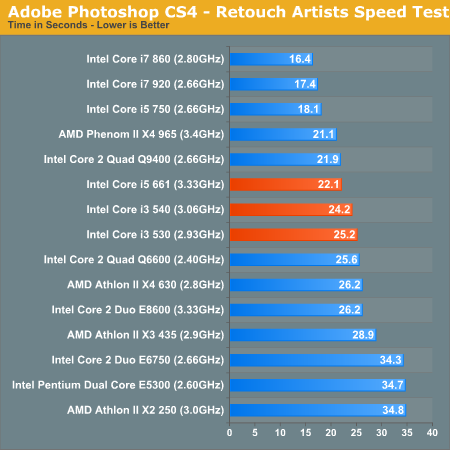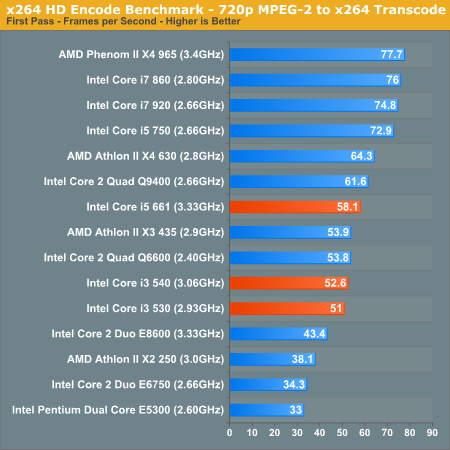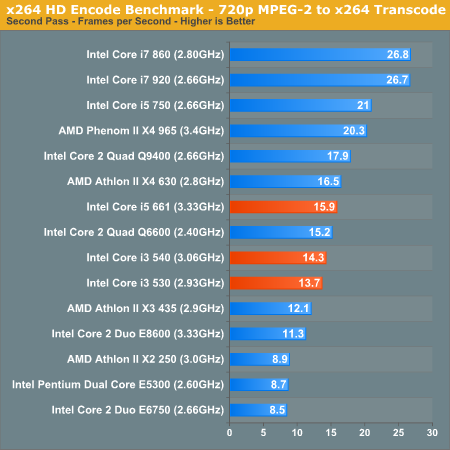The Clarkdale Review: Intel's Core i5 661, i3 540 & i3 530
by Anand Lal Shimpi on January 4, 2010 12:00 AM EST- Posted in
- CPUs
Adobe Photoshop CS4 Performance
To measure performance under Photoshop CS4 we turn to the Retouch Artists’ Speed Test. The test does basic photo editing; there are a couple of color space conversions, many layer creations, color curve adjustment, image and canvas size adjustment, unsharp mask, and finally a gaussian blur performed on the entire image.
The whole process is timed and thanks to the use of Intel's X25-M SSD as our test bed hard drive, performance is far more predictable than back when we used to test on mechanical disks.
Time is reported in seconds and the lower numbers mean better performance. The test is multithreaded and can hit all four cores in a quad-core machine.

And this is where everything changes. While our Photoshop test won't keep four cores busy 100% of the time, it's enough to give the quad-core CPUs an advantage. Here the Core i5 661 is around the speed of a Q9400 but nowhere near the similarly priced Lynnfield Core i5 750.
The Core i3 540/530 are valuable as they are both able to outperform AMD's similarly priced Athlon II X4 630. The 661 doesn't make sense here but for the price, the i3 530/540 look promising.
DivX 8.5.3 with Xmpeg 5.0.3
Our DivX test is the same DivX / XMpeg 5.03 test we've run for the past few years now, the 1080p source file is encoded using the unconstrained DivX profile, quality/performance is set balanced at 5 and enhanced multithreading is enabled:

Video encoding is where you need more cores, and this is where the Core i5 661 really loses out in terms of value. It's the same price as a Core i5 750 but it's clearly slower. Turbo isn't saving the 661.
The Core i3 540 and 530 however look competitive. They're able to perform at around the same level as AMD's Athlon II X4 630, while drawing much less power.
x264 HD Video Encoding Performance
Graysky's x264 HD test uses the publicly available x264 encoder to encode a 4Mbps 720p MPEG-2 source. The focus here is on quality rather than speed, thus the benchmark uses a 2-pass encode and reports the average frame rate in each pass.

Competitive in DivX encoding, yes. But in our x264 encoding test, these Clarkdales just don't make sense. If you do a lot of x264 video encoding you're going to want Lynnfield or a quad-core Athlon II/Phenom II.

Windows Media Encoder 9 x64 Advanced Profile
In order to be codec agnostic we've got a Windows Media Encoder benchmark looking at the same sort of thing we've been doing in the DivX and x264 tests, but using WME instead.

Rounding out our video encoding tests Windows Media Encoder 9 doesn't really show us anything different. The Core i5 661 is slower than it should be given its price, and here even the i3s lose out. If you do a lot of encoding, you want four cores. Simple as that.










93 Comments
View All Comments
Paladin1211 - Monday, January 4, 2010 - link
On page 13, in WoW benchmark, the Core i5 750 outperforms the Core i7 870 by more than 30% (92.3 fps vs 70.6 fps). Anything wrong here?Crimson67 - Tuesday, January 5, 2010 - link
WoW doesn't seem to like hyperthreading, it's the only explanationereavis - Wednesday, January 6, 2010 - link
is it using the hyperthread core on the 870 but a true core on the 750? That would certainly slow it down. If it's using a true core on both it should be better still.Dyzios - Monday, January 4, 2010 - link
Remember NVIDIA Hybrid idea, to have two GPUs ? - one weak for 2D/light 3D graphics and powerful discrete GPU for gaming? Those CPU makes sense for this approach - however Radeon 5870 also has good point with optimized low idle power consumption. Maybe still there is point as even Radeon cannot go very low as GPU on-die. The only question is to have capability to switch HDMI output between on-die GPU and discrete.I wonder how this works currently - still needed to stick to DVI output from Radeon or can be combined?Zool - Tuesday, January 5, 2010 - link
If the 40nm 5600 series cards will show the same improvments in power usage than the 5800 series than u can forget the intels GMA graphic.I think that for a 2D card/3D discret card u can buy a mobo with a dirty cheap intel GMA on it clocked much lower if u realy need.
silverblue - Wednesday, January 6, 2010 - link
The graphics comparison isn't exactly fair but in the end, it's not something AMD should be too worried about. The i5-661, with its 900MHz 45nm GPU, is being compared to the old 790GX's HD 3300 which operates at 700MHz on a 55nm process. I admit, in the benchmarks we're talking the best i5 vs. the best AMD has to offer, but considering...a) the relative performance of the i5-750 as compared to the PII X4 965 which is usually manifested as an advantage
b) the fact that the 32nm i5s can increase their core speed by 133MHz and 266MHz thanks to Turbo depending on the number of active cores
c) most games still aren't designed to take full advantage of multithreading so four cores may not yield a tangible performance increase
...then AMD's still in the lead for IGPs. If the 3300 had been clocked at 900MHz, would it have lost even one of the listed benchmarks? I'm not sure it would have. What's more, we're still talking a 55nm part; we all know of TSMC's issues with the 40nm process and AMD going fablress, so is it unreasonable to expect that AMD could move their IGP production en masse to 40nm with TSMC or 45nm with GlobalFoundries?
In closing, it's a big step forward for Intel, however if AMD came out with a higher clocked 40/45nm IGP then, Sideport or not, new tech or not, AMD would be far ahead, at least on gaming terms. Sideport does very little for the performance of current AMD IGPs, anyway.
I just wish AMD were able to release a Clarkdale competitor sooner rather than later.
ruetheday - Friday, January 8, 2010 - link
the IGP on Clarkdale isn't maxed out at 900Mhz; It too can be overclocked significantly. Here's an article on techgage showing an OC to 1133, for example.Remember that Intel is very conservative on binning parts to ensure no issues with reliability over time (compare vs nvidia mobile gpus).
silverblue - Friday, January 8, 2010 - link
Maybe so, however a 40/45nm AMD part could reach similar clockspeeds. I just don't think that, clock for clock, the new Intel IGP on the Clarkdale die is as powerful as anything AMD or nVidia can produce on the same scale. It's a good step forwards, just not the leadership that some may have been expecting.silverblue - Wednesday, January 6, 2010 - link
Slight mistake... second best 32nm i5 that Intel has to offer. However, I doubt the performance increase over the 661 will be very noticable with the IGP; won't it be clocked the same in both?Zool - Monday, January 4, 2010 - link
The irony is the biggest drawback of these cpu-s is the 45nm intel graphic on other die with the memmory controler. The die savings from 45nm vs 32nm are quite big.If they would make just 32nm dual core nehalem with memory controler on die it would be still much smaller(and only litle bigger than the clarkdale without imc) than the GMA die with memmory controler.
The whole thing would be solved with everything as one on 32nm.
I think plenty of people just wait for 32nm quad core nehalems without the useless GMA graphic.
Actualy what is the cost of dirty cheap GMA in penryn based 3 package boards. Like 5-10 dolars ?